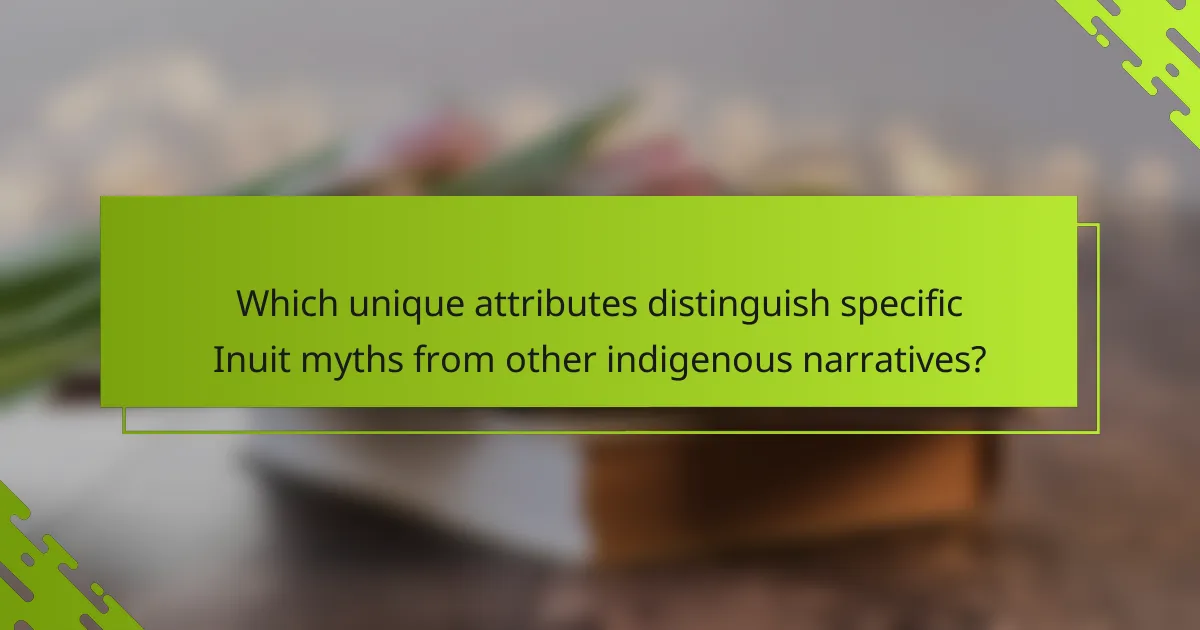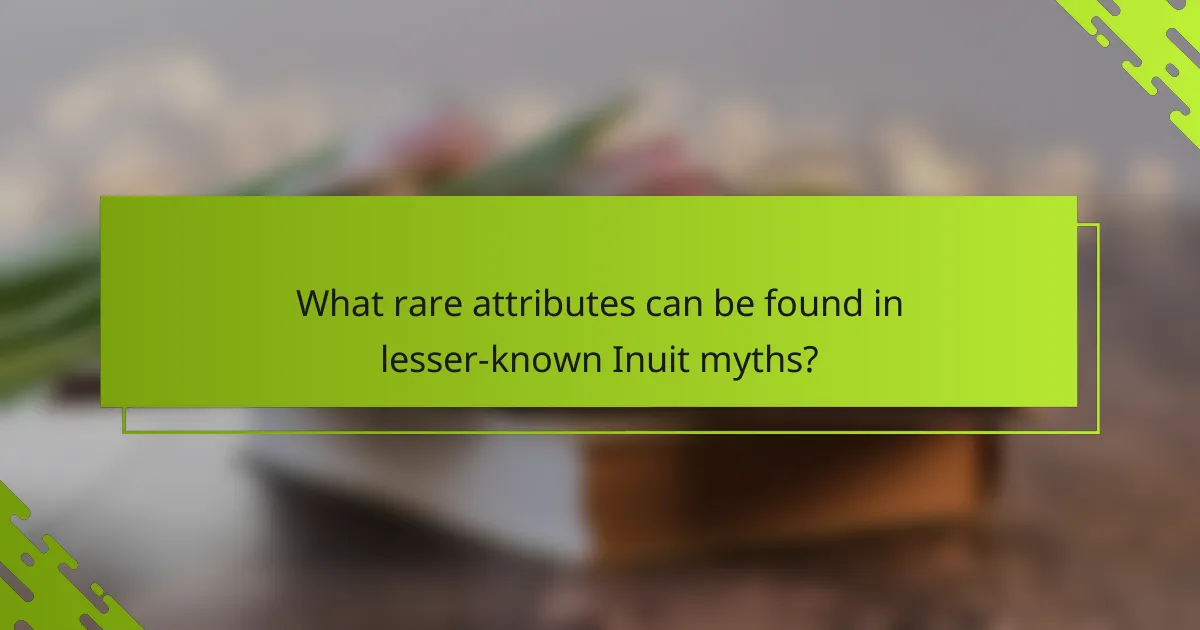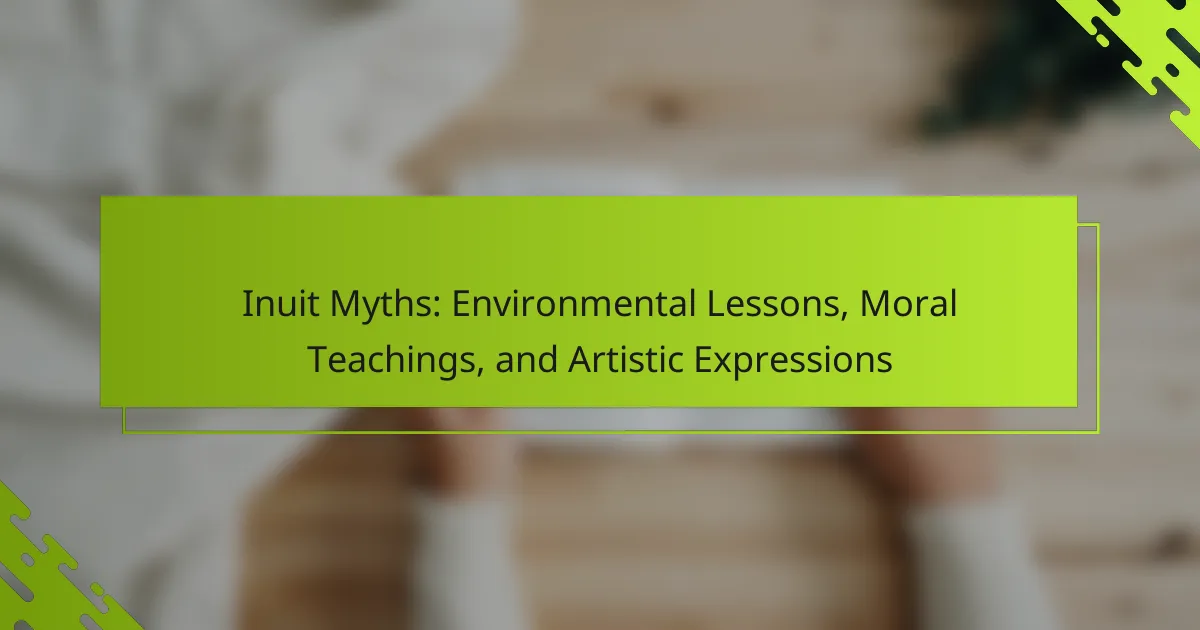Inuit myths offer crucial insights into environmental stewardship, community values, and artistic expression. They emphasize respect for nature and the interconnectedness of life. These narratives provide moral teachings that foster harmony and cooperation among community members. Additionally, artistic forms like storytelling and carving preserve these lessons, enriching cultural identity and ecological wisdom.

What environmental lessons can be learned from Inuit myths?
Inuit myths convey valuable environmental lessons emphasizing respect for nature. They teach the importance of balance, sustainability, and the interconnectedness of all living things. These stories illustrate how human actions impact the environment, promoting stewardship and conservation. By understanding these narratives, we gain insights into traditional ecological knowledge that can inform modern environmental practices.
How do Inuit myths reflect the relationship between humans and nature?
Inuit myths illustrate the deep connection between humans and nature, emphasizing respect and balance. These narratives often depict the environment as a living entity, highlighting the interdependence of all beings. For instance, stories about the sea and animals convey moral lessons about sustainability and coexistence. The unique attribute of Inuit myths lies in their ability to blend environmental wisdom with cultural identity, reinforcing the importance of harmony with nature. As a result, these myths serve as artistic expressions that resonate with contemporary environmental issues.
Which specific myths illustrate ecological sustainability?
Inuit myths often illustrate ecological sustainability through their deep respect for nature and interconnectedness of life. These stories convey moral teachings that emphasize balance, stewardship, and the importance of respecting animal spirits. For example, the tale of the Raven highlights the need for harmony between humans and the environment, showcasing how actions impact the natural world. Additionally, myths about the sea and land animals teach resource conservation and the significance of seasonal cycles, reinforcing sustainable practices.
What role do animals play in conveying environmental messages?
Animals in Inuit myths convey environmental messages by embodying moral teachings and cultural values. These stories illustrate the interconnectedness of nature and humanity, emphasizing respect for wildlife and the environment. For example, the tale of the raven often highlights themes of creation and transformation, showcasing how animals influence ecological balance. Such narratives serve as cautionary tales, urging sustainable practices and reverence for natural resources. Through artistic expressions, these myths preserve knowledge and foster a sense of responsibility towards the environment.
How have modern Inuit communities adapted these lessons to current environmental challenges?
Modern Inuit communities have adapted lessons from their myths to address environmental challenges by emphasizing sustainability and respect for nature. They integrate traditional knowledge with contemporary practices to manage resources effectively. For instance, community-led initiatives focus on preserving wildlife and adapting hunting practices to changing climates. Furthermore, artistic expressions, such as storytelling and visual art, reinforce these environmental messages, fostering a collective identity centered on ecological stewardship. These adaptations highlight the resilience and cultural continuity of Inuit communities in the face of modern environmental issues.

What moral teachings are embedded in Inuit myths?
Inuit myths embed moral teachings that emphasize respect for nature, community values, and the importance of balance. These stories often illustrate the consequences of human actions, promoting harmony with the environment. For example, tales of the Raven highlight themes of wisdom and responsibility. Additionally, myths encourage cooperation and sharing among community members, reinforcing social bonds. Through artistic expressions, these narratives convey deep environmental lessons and moral principles that guide Inuit life.
How do Inuit stories promote social values and community cohesion?
Inuit stories promote social values and community cohesion by reinforcing shared beliefs and cultural identity. These narratives often convey moral teachings, emphasizing respect for nature and communal responsibility. Environmental lessons embedded in myths encourage sustainable practices, fostering a sense of stewardship among community members. Artistic expressions, such as storytelling and visual arts, serve as mediums for transmitting these values, uniting individuals through shared experiences and collective memory. This interconnectedness strengthens community bonds, ensuring the preservation of Inuit culture across generations.
Which characters in Inuit myths serve as moral exemplars?
Inuit myths feature several characters as moral exemplars, notably Raven, Nanook, and Sedna. Raven embodies cunning and adaptability, teaching the importance of resourcefulness. Nanook represents strength and respect for nature, emphasizing the need for harmony with the environment. Sedna, the sea goddess, illustrates themes of sacrifice and the consequences of one’s actions, highlighting moral responsibility. These characters collectively impart essential lessons about ethics, community, and environmental stewardship within Inuit culture.
What lessons do Inuit myths impart about respect and reciprocity?
Inuit myths impart vital lessons about respect and reciprocity, emphasizing interconnectedness with nature. These stories illustrate the importance of honoring relationships with animals and the environment. For instance, many myths depict the need for balance; taking resources requires giving back, reinforcing sustainability. Such teachings foster a deep respect for all living beings, advocating for a harmonious coexistence.

How do Inuit myths manifest in artistic expressions?
Inuit myths manifest in artistic expressions through storytelling, visual art, and performance. These forms convey environmental lessons, moral teachings, and cultural values. For example, carvings often depict animals and spirits, reflecting the relationship between Inuit people and their environment. Traditional songs and dances communicate moral narratives, emphasizing community and respect for nature. Artistic expressions serve as a medium for preserving and transmitting these myths, reinforcing cultural identity and continuity.
What forms of art are inspired by Inuit mythology?
Inuit mythology inspires various forms of art, including sculpture, painting, storytelling, and textiles. These artistic expressions often reflect environmental themes and moral lessons inherent in the myths. Sculpture, particularly in soapstone, depicts mythological figures and animals, showcasing unique attributes of Inuit culture. Painting often illustrates stories and landscapes, capturing the essence of the environment. Storytelling remains a vital oral tradition, conveying moral teachings and environmental wisdom. Textiles, like woven items, incorporate mythological motifs, blending functionality with cultural expression. Each art form serves to preserve and communicate Inuit heritage.
How do visual arts convey the themes of Inuit myths?
Visual arts convey Inuit myths through symbolism, color, and form, illustrating environmental lessons and moral teachings. Artists use imagery of animals, nature, and ancestral spirits to express interconnectedness with the environment. For instance, depictions of the land and sea highlight respect for nature and sustainability. Additionally, narratives embedded in artwork reinforce community values and cultural identity. The unique attribute of Inuit art lies in its oral tradition, where stories are visually interpreted, preserving history and wisdom across generations.
In what ways do storytelling and performance art preserve Inuit cultural heritage?
Storytelling and performance art preserve Inuit cultural heritage by transmitting environmental lessons, moral teachings, and artistic expressions. These forms engage communities, fostering identity and continuity.
Inuit myths often emphasize the relationship between humans and nature, teaching sustainability. Performance art, such as drum dancing, embodies these stories, allowing for experiential learning. This dynamic interaction reinforces cultural values and collective memory.
Additionally, storytelling serves as a medium for moral teachings. Characters in myths often reflect virtues like respect and cooperation, guiding behavior within the community. This oral tradition ensures that knowledge is passed down through generations.
Artistic expressions, including carving and throat singing, further enrich Inuit culture. These practices not only showcase artistic skills but also encapsulate historical narratives, enhancing cultural resilience amidst modern challenges.

Which unique attributes distinguish specific Inuit myths from other indigenous narratives?
Inuit myths are distinguished by their deep connection to the Arctic environment, unique moral teachings, and artistic expressions. These narratives emphasize survival, respect for nature, and community values. Unlike many other indigenous myths, Inuit stories often incorporate elements of the harsh Arctic landscape, illustrating how these challenges shape cultural beliefs and practices. Unique attributes include the focus on animal spirits and the integration of oral traditions with visual arts, such as carving and storytelling. This artistic expression serves to preserve and convey environmental lessons and moral teachings within the community.
What are the most iconic Inuit myths and their cultural significance?
Inuit myths encompass environmental lessons, moral teachings, and artistic expressions that reflect cultural significance. These narratives often emphasize the relationship between humans and nature, illustrating survival in harsh climates.
One iconic myth is the story of Sedna, the sea goddess, who embodies the Inuit’s respect for marine life. Her tale teaches the importance of balance in nature and the consequences of disrespecting the environment.
Another notable myth is the story of the trickster figure, Raven, who symbolizes creativity and transformation. Ravens’ actions reveal moral lessons about wisdom, folly, and the interconnectedness of life.
These myths serve as a means of cultural preservation, passing down values and traditions through generations while also inspiring artistic expressions in storytelling, carving, and dance.
How do regional variations influence the storytelling of Inuit myths?
Regional variations significantly influence Inuit myths by reflecting local environments and cultural practices. These stories often incorporate elements unique to specific regions, such as the types of animals, weather conditions, and geographical features. For instance, coastal Inuit myths may emphasize marine life, while interior myths focus on land animals. This connection to the environment serves as a vital educational tool, imparting lessons on survival and respect for nature. Additionally, storytelling styles and artistic expressions vary, showcasing the diverse ways Inuit communities interpret their surroundings and experiences. Such variations enrich the overall tapestry of Inuit mythology, making it a dynamic reflection of their relationship with the land.

What rare attributes can be found in lesser-known Inuit myths?
Lesser-known Inuit myths feature rare attributes that highlight unique environmental lessons and moral teachings. These myths often incorporate unusual animal transformations, such as humans turning into sea creatures or birds, reflecting the interconnectedness of life. They may also include rare elements like spirits representing natural phenomena, which serve to explain weather patterns or natural disasters. Additionally, some myths emphasize the importance of specific plants or animals in survival, showcasing a deep understanding of the environment. These attributes enrich the cultural narrative and provide insights into Inuit values and ecological wisdom.
Which obscure myths provide insight into ancient Inuit life?
Inuit myths provide valuable insights into ancient life by illustrating environmental lessons, moral teachings, and artistic expressions. These stories often emphasize the interconnectedness of humans and nature, teaching respect for the environment. For example, the myth of Sedna, the sea goddess, highlights the importance of balance in marine ecosystems. Additionally, myths convey moral lessons, such as the consequences of greed and disrespect. Artistic expressions in these myths showcase Inuit culture, reflecting their values and beliefs through storytelling and visual art forms. These elements together reveal the depth of Inuit understanding of their world.
How do these rare tales contribute to the overall understanding of Inuit culture?
Rare tales enhance understanding of Inuit culture by illustrating environmental wisdom, moral values, and artistic expression. These narratives convey lessons about nature, emphasizing respect for the land and its resources. They also reflect community values, teaching ethical behavior and interpersonal relationships. Additionally, the artistic elements in these myths foster cultural identity and continuity, preserving traditions for future generations. Through these dimensions, rare tales create a richer, multifaceted view of Inuit culture.

What practical strategies can be derived from Inuit myths for modern environmental stewardship?
Inuit myths provide valuable strategies for modern environmental stewardship by emphasizing harmony with nature and respect for all living beings. These narratives encourage sustainable practices, such as the careful management of natural resources and the importance of community involvement in environmental care.
For example, the story of the raven teaches the significance of balance in ecosystems. It illustrates how overexploitation can lead to dire consequences, urging contemporary societies to adopt conservation methods. Inuit teachings also promote the idea of interconnectedness, reminding us that human actions impact the environment and future generations.
Furthermore, traditional knowledge embedded in these myths can guide modern practices. Engaging with Indigenous perspectives fosters a deeper understanding of local ecosystems, enhancing biodiversity preservation. By integrating these lessons, communities can develop effective stewardship strategies that honor both cultural heritage and ecological responsibility.
How can individuals apply lessons from Inuit mythology to everyday life?
Individuals can apply lessons from Inuit mythology to everyday life by embracing environmental stewardship, moral integrity, and creativity. Inuit myths emphasize respect for nature, teaching the importance of sustainability. For instance, the story of Sedna highlights the interconnectedness of all living beings, encouraging a sense of responsibility towards the environment. Additionally, moral teachings in these myths promote values like community cooperation and humility, which can enhance interpersonal relationships. Artistic expressions found in Inuit culture inspire creativity, encouraging individuals to explore their own artistic potential while connecting with cultural heritage.
What are common misconceptions about Inuit myths and their teachings?
Many misconceptions exist about Inuit myths, primarily regarding their teachings and significance. Some believe these myths are merely primitive stories without depth. In reality, they convey complex environmental lessons, moral teachings, and artistic expressions.
Another common misconception is that Inuit myths lack relevance to contemporary issues. However, these narratives often address themes such as sustainability and respect for nature, providing valuable insights for modern environmental challenges.
Additionally, some view Inuit myths as solely oral traditions. While oral storytelling is vital, many myths are also expressed through visual art, enhancing their cultural significance.
Lastly, people often assume Inuit myths are homogeneous. In truth, there is a rich diversity among different Inuit communities, each with unique stories and interpretations that reflect their specific environments and experiences.
Which best practices can be drawn from the study of Inuit myths for cultural preservation?
Inuit myths offer valuable best practices for cultural preservation through their emphasis on environmental stewardship, moral teachings, and artistic expressions. These myths serve as a repository of knowledge about sustainable practices, fostering respect for nature. They impart moral lessons that reinforce community values and social cohesion. Additionally, the rich artistic expressions found in Inuit storytelling and visual arts promote cultural identity and continuity. By integrating these elements, communities can strengthen their cultural heritage and adapt to modern challenges while maintaining their unique identity.
